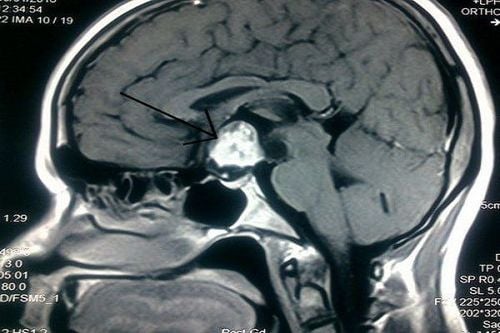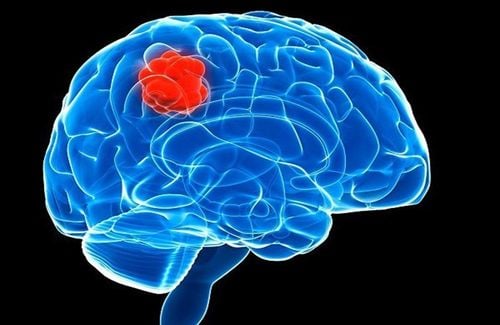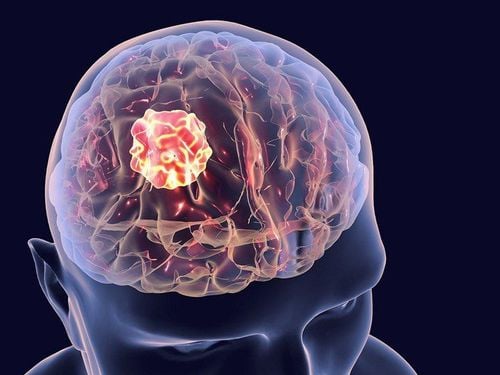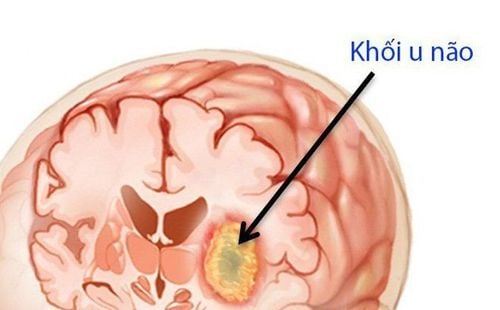This is an automatically translated article.
The article was professionally consulted by Specialist Doctor I Tran Cong Trinh - Radiologist - Radiology Department - Vinmec Central Park International General Hospital. The doctor has many years of experience in the field of diagnostic imaging.A brain tumor is an abnormal mass or growth of cells in the brain. There are many types of brain tumors such as benign and malignant brain tumors. Brain tumors can start in the brain or cancer can start in other parts of the body and spread to the brain. Currently, there are many techniques used to diagnose brain tumors as cancer or not.
1. Symptoms of brain tumor
A brain tumor is a collection or mass of abnormal cells in the brain. The skull that surrounds your brain is very stiff. Any growth inside such tight spaces can cause various problems.Brain tumors can be cancerous (malignant) or noncancerous (benign). As benign or malignant tumors grow, they can increase pressure inside the skull leading to brain damage that can be life-threatening.
Brain tumors are classified as primary and secondary. Primary brain tumors originate in the brain and secondary brain tumors, also known as metastatic brain tumors, occur when cancer cells spread to the brain from another organ and spread to the brain, such as lung or breast cancer.
The signs and symptoms of brain tumors vary widely and depend on the size, location, and growth rate of the brain tumor. General signs and symptoms of brain tumors may include:
Initiating or phenotypically changing headaches Headaches that increase and become more frequent and severe Unexplained nausea or vomiting Experience other symptoms vision problems, such as blurred vision, double vision, or loss of peripheral vision Gradual loss of feeling or ability to move in an arm or leg Difficulty with balance Difficulty speaking Confusion in problems daily Changes in personality or behavior Seizures, especially in people with no history of seizures Having problems with hearing.

Người mắc U não có thể buồn nôn hoặc nôn không rõ nguyên nhân
2. Causes of Brain Tumors
2.1 Brain Tumors That Begin in the Brain Primary brain tumors originate in the brain itself or in tissues close to it, such as in the meninges, cranial nerves, pituitary gland, or pineal gland.Primary brain tumors start when normal cells have errors (mutations) in their DNA. These mutations cause cells to grow, divide at an increased rate, and continue to live, while healthy cells die. The result is the formation of a mass of abnormal cells, forming a tumor.
In adults, primary brain tumors are much less common than secondary brain tumors, in which cancer begins elsewhere and spreads to the brain.
Many different types of primary brain tumors exist. Each disease is named after the cell type involved. Examples include:
Glioma . These tumors start in the brain or spinal cord and include astrocytomas, ependymomas, glioblastomas, mixed gliomas (oligoastrocytomas), and gliomas. oligodendrogliomas (oligodendrogliomas). Meningiomas . Meningiomas are tumors that arise from the membranes surrounding the brain and spinal cord. Most meningiomas are not cancerous. schwannomas). This is a benign tumor that grows on the nerves, most often in the nerve that controls balance and hearing leading from the inner ear to the brain (the VIII nerve). Pituitary adenomas. These are mostly benign tumors that develop in the pituitary gland at the base of the brain. These tumors can affect pituitary hormones with effects throughout the body. Medulloblastomas. It is the most common brain cancerous tumor in children. A myeloma that begins in the lower part of the brain and tends to spread through the cerebrospinal fluid. Germ cell tumors. Germ cell tumors can develop during childhood, where the testicles or ovaries will form. But sometimes germ cell tumors affect other parts of the body, such as the brain. Craniopharyngeal tumors (Craniopharyngiomas). This is a rare and noncancerous tumor that begins near the pituitary gland of the brain, which secretes hormones that control many body functions. When craniopharyngioma grows slowly, it can affect the pituitary gland and other structures near the brain.

Hình ảnh U tuyến yên trên kết quả chụp CT-Scaner
Secondary brain tumors often occur in people with a history of cancer. But in rare cases, metastatic brain tumors can be the first sign of cancer starting elsewhere in the body.
In adults, secondary brain tumors are much more common than primary brain tumors. Any cancer can spread to the brain, but common types include:
Breast cancer Colon cancer Kidney cancer Lung cancer Melanoma
3. How is a brain tumor diagnosed and evaluated?
To diagnose and evaluate brain tumors, doctors may assign patients to perform one of the following imaging techniques:Brain MRI: Magnetic resonance imaging (MRI) using strong magnetic fields, radiofrequency pulses and computers to create detailed images of organs, soft tissues, bones, and almost all structures inside the body. MRI provides detailed images that can detect brain abnormalities such as tumors and infections. MRI is highly sensitive for tumor detection and assessment of the surrounding area to determine the extent of tumor involvement. MRI of the spine: Like an MRI of the head, an MRI of the spine uses a strong magnetic field, radiofrequency pulses, and a computer to show the anatomical structure of the vertebrae, as well as the discs, spinal cord, and spaces between vertebrae for the passage of nerves. This technique can be used to detect tumors that have arisen or spread to the spine and/or spinal cord or the fluid that surrounds it (cerebrospinal fluid). Brain fMRI: Functional magnetic resonance imaging (fMRI) uses MR imaging to measure metabolic changes taking place in the brain. In the case of a brain tumor diagnosis, this technique is performed to evaluate areas in the brain involved in language and muscle movement. It is also used to monitor tumor growth and function and assess potential risks of surgery or other invasive treatments. Brain CT scan: Computerized tomography (CT) scans combine special X-ray equipment and sophisticated computers to create a variety of pictures of the inside of the body. This technique can detect brain tumors as well as help plan radiation therapy with treatment goals. CT can also detect bleeding or edema in the brain. PET and PET/CT head scans: Positron emission tomography (PET) is a diagnostic technique that uses a small amount of a radioactive tracer (called a radiotracer) to help diagnose and determine the severity of many diseases. Combined PET/CT scans are used from combining images from PET and CT scans together and produce details of both the anatomy (from the CT scan) and function (from the PET scan) of the brain. This technique can measure how brain tumors use glucose. Other radioactive tracer also have the function of imaging low-oxygen areas in the tumor.

Chụp PET và PET/CT đầu giúp chẩn đoán và đánh giá khối u não
Please dial HOTLINE for more information or register for an appointment HERE. Download MyVinmec app to make appointments faster and to manage your bookings easily.
Articles refer to sources: radiologyinfo.org, mayoclinic.org













